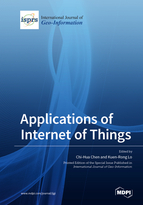Applications of Internet of Things
A special issue of ISPRS International Journal of Geo-Information (ISSN 2220-9964).
Deadline for manuscript submissions: closed (31 December 2016) | Viewed by 41090
Special Issue Editors
Interests: machine learning; internet of things; healthcare systems
Special Issues, Collections and Topics in MDPI journals
Interests: internet of things; smart city; intelligent transportation system
Special Issues, Collections and Topics in MDPI journals
Special Issue Information
Dear Colleagues,
In recent years, the techniques of Internet of Things (IoT) and mobile communication have been developed to detect human and environment information (e.g., geo-information, weather information, bio-information, human behaviours, etc.) for a variety of intelligent services and applications. The three layers in IoT are sensor, networking, and application layers. For sensor and networking layers, the rise of mobile technology advancements (e.g., wireless sensor networking, Wi-Fi, Bluetooth, smart mobile device, and Long Term Evolution (LTE)) has led to a new wave of machine-to-machine (M2M), machine-to-human (M2H), human-to-human (H2H), and human-to-machine (H2M) communications. For the application layer, several IoT applications, which include energy, enterprise, healthcare, public services, residency, retail, and transportation, have been designed and implemented to detect environmental changes and send instant updates to a cloud computing server farm via mobile communications and middleware for big geo-data analyses. For instance, on-board units in cars can instantly detect and share information about the geolocation of the car, speed, following distance, and gaps with other neighboring cars. While the area of IoT applications and mobile communication is a rapidly expanding field of scientific research, several open research questions still need to be discussed and studied. This Special Issue will solicit papers on various disciplines of IoT. Potential topics include, but are not limited to:
- IoT Applications of Agriculture
- IoT Applications of Energy
- IoT Applications of Enterprise
- IoT Applications of Finance
- IoT Applications of Healthcare
- IoT Applications of Industry
- IoT Applications of Public Services
- IoT Applications of Residency
- IoT Applications of Retail
- IoT Applications of Transportation
- Sensing Techniques for IoT
- Communication Techniques for IoT
- Middleware Techniques for IoT
- Data Analysis Techniques for IoT
Dr. Chi-Hua Chen
Dr. Kuen-Rong Lo
Guest Editor
Manuscript Submission Information
Manuscripts should be submitted online at www.mdpi.com by registering and logging in to this website. Once you are registered, click here to go to the submission form. Manuscripts can be submitted until the deadline. All submissions that pass pre-check are peer-reviewed. Accepted papers will be published continuously in the journal (as soon as accepted) and will be listed together on the special issue website. Research articles, review articles as well as short communications are invited. For planned papers, a title and short abstract (about 100 words) can be sent to the Editorial Office for announcement on this website.
Submitted manuscripts should not have been published previously, nor be under consideration for publication elsewhere (except conference proceedings papers). All manuscripts are thoroughly refereed through a single-blind peer-review process. A guide for authors and other relevant information for submission of manuscripts is available on the Instructions for Authors page. ISPRS International Journal of Geo-Information is an international peer-reviewed open access monthly journal published by MDPI.
Please visit the Instructions for Authors page before submitting a manuscript. The Article Processing Charge (APC) for publication in this open access journal is 1700 CHF (Swiss Francs). Submitted papers should be well formatted and use good English. Authors may use MDPI's English editing service prior to publication or during author revisions.







